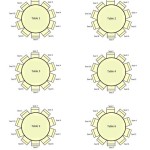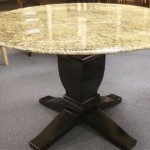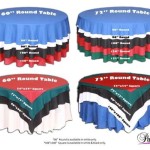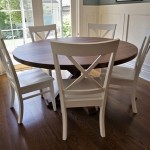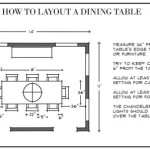Creating A Cozy Dining Space With A 4-Chair Round Table Setting
The dining area serves as a focal point within a dwelling, transcending its functional purpose of food consumption to become a space for social interaction and shared experiences. The selection and arrangement of furniture, particularly the dining table and accompanying chairs, are crucial in shaping the ambiance and functionality of the room. A 4-chair round table setting offers a unique approach to spatial design, promoting intimacy and facilitating conversation. This article delves into the considerations involved in creating a cozy dining space using this specific configuration.
The shape of a round table inherently encourages a sense of equality and inclusivity. Unlike rectangular or square tables, a circular design eliminates a designated head of the table, fostering a more egalitarian dining experience. This is especially beneficial for smaller gatherings where the emphasis is on fostering close interaction and intimate conversation. The absence of corners also creates a softer, more inviting visual aesthetic, contributing to the overall feeling of coziness.
Before embarking on the design process, it is paramount to assess the available space. A round table requires ample room to accommodate both the table itself and the chairs, allowing for comfortable movement around the perimeter. Measure the dimensions of the dining area with precision, taking into account any existing architectural features such as doorways, windows, and built-in cabinetry. Visualizing the placement of the table and chairs using painter's tape on the floor can provide a valuable perspective on spatial relationships and potential traffic flow obstructions.
The diameter of the round table will directly influence the comfort and functionality of the dining space. A table that is too small may feel cramped and restrict elbow room, while one that is excessively large can overwhelm the room and hinder conversation. Generally, a round table with a diameter of 42 to 48 inches is suitable for seating four individuals comfortably. However, individual preferences and the specific dimensions of the chairs should also be considered. It is advisable to physically test the table and chair combination to ensure adequate space for diners to sit comfortably without feeling confined.
Selecting chairs that complement both the table and the overall aesthetic of the dining space is essential. The chairs should be proportionate to the size of the table and offer adequate support and comfort for extended periods of sitting. The style of the chairs can range from traditional to contemporary, depending on the desired ambiance. Upholstered chairs provide an added layer of comfort and can contribute to a more luxurious feel. Alternatively, wooden or metal chairs offer a more minimalist and streamlined look. Regardless of the style chosen, it is crucial to ensure that the chairs are durable and well-constructed to withstand regular use.
The material and finish of the table and chairs play a significant role in defining the aesthetic of the dining space. Wood is a classic choice that offers warmth and versatility, blending seamlessly with a variety of design styles. Lighter woods such as maple and birch create a bright and airy feel, while darker woods such as walnut and mahogany evoke a sense of sophistication and grandeur. Metal tables and chairs offer a more industrial and contemporary aesthetic. Glass-topped tables can create a sense of openness and lightness, making them a suitable choice for smaller dining areas. The finish of the furniture should be durable and easy to clean, ensuring long-lasting beauty and functionality.
Beyond the basic furniture, accessories and decorative elements are essential in creating a truly cozy dining space. Consider incorporating a rug beneath the table and chairs to define the space and add warmth and texture. The rug should be large enough to accommodate all the chairs comfortably, even when they are pulled out from the table. Wall decor, such as artwork, mirrors, or shelving, can add visual interest and personality to the room. Lighting is another crucial element. A chandelier or pendant light suspended above the table can create a focal point and provide ambient lighting. Additional lighting sources, such as sconces or table lamps, can be used to supplement the overhead lighting and create a layered and inviting atmosphere.
Ultimately, creating a cozy dining space is a process of careful planning and attention to detail. By considering the size of the space, the dimensions of the table and chairs, the materials and finishes used, and the addition of carefully chosen accessories, it is possible to transform a functional dining area into a warm and inviting space for shared meals and lasting memories.
Key Considerations in Choosing a Round Table
The selection of a round table involves several critical considerations beyond simply choosing the desired aesthetic. Functional aspects, spatial constraints, and material properties all contribute to the overall success of the dining area design. A thorough evaluation of these factors will ensure the selected table effectively serves its intended purpose while harmonizing with the surrounding environment.
One of the primary considerations is the size of the table. This is not solely determined by the number of intended diners but also by the available space within the dining room. A too-large table can overwhelm a small room, making it feel cramped and uncomfortable. Conversely, a table that is too small will not adequately accommodate the diners and their meals. As previously mentioned, a diameter between 42 and 48 inches is generally suitable for a 4-chair setting. However, this is a guideline only and should be adjusted based on personal preferences and the dimensions of the chairs being used.
The material of the table plays a crucial role in its durability and aesthetic appeal. Solid wood offers a timeless and robust solution, providing inherent warmth and character. Different wood types offer varying levels of hardness and resistance to scratches and dents. Engineered wood, such as plywood or MDF, provides a more cost-effective alternative, often finished with veneer for a similar visual effect. However, engineered wood may not be as durable as solid wood and can be more susceptible to water damage. Metal tables offer a contemporary and industrial aesthetic, often paired with glass or wood tops. These tables are typically very durable and easy to maintain.
The table's base design also warrants careful consideration. Pedestal bases offer ample legroom and create a clean, uncluttered look. However, they may not be as stable as tables with four legs, particularly when the table is larger or heavier. Tables with four legs provide excellent stability but may restrict legroom, especially for diners seated at the corners. The design of the legs should also complement the overall style of the dining room.
Optimizing Comfort and Functionality with Chair Selection
The selection of dining chairs extends beyond mere aesthetics; it is fundamentally about providing comfort and ensuring the functional needs of the dining space are met. Chairs that are uncomfortable or inappropriately sized can detract from the dining experience, making it difficult for guests to relax and enjoy their meals. Therefore, a strategic approach to chair selection is essential.
Seat height is a critical factor in ensuring proper posture and comfort. The ideal seat height allows diners to rest their feet comfortably on the floor while maintaining a 90-degree angle at the knees. A seat height that is too high will cause discomfort in the legs and feet, while a seat height that is too low will force diners to slouch, leading to back pain. Generally, a seat height of 18 to 20 inches is considered appropriate for standard dining tables. However, it is always advisable to measure the height of the table and select chairs accordingly.
The back support provided by the chairs is another crucial consideration. Chairs with high backs offer more support for the upper back and shoulders, while chairs with low backs provide more freedom of movement. The design of the backrest should be ergonomically sound, conforming to the natural curvature of the spine. Upholstered backrests provide an added layer of comfort and can help to reduce fatigue during extended periods of sitting. The material used for the upholstery should be durable and easy to clean, particularly if the chairs are likely to be used frequently.
The width and depth of the seat also contribute to overall comfort. A seat that is too narrow will feel cramped and restrictive, while a seat that is too deep will make it difficult for diners to reach the table comfortably. The ideal seat width and depth will depend on the size and build of the individuals who will be using the chairs. It is generally recommended to choose chairs with a seat width of at least 18 inches and a seat depth of at least 16 inches.
Enhancing the Ambiance with Accessories and Lighting
The final layer in creating a cozy dining space lies in the strategic use of accessories and lighting. These elements contribute significantly to the overall ambiance, transforming a functional dining area into a welcoming and inviting space. Careful consideration of color palettes, textures, and light sources is crucial in achieving the desired atmosphere.
The choice of a rug can dramatically impact the perceived warmth and intimacy of the dining area. A rug not only defines the space occupied by the table and chairs but also adds texture and visual interest to the floor. The size of the rug is crucial; it should be large enough to accommodate all the chairs comfortably, even when pulled out from the table. The material of the rug should be durable and easy to clean, especially in a dining environment where spills are likely to occur. Wool rugs offer excellent durability and stain resistance, while synthetic rugs are a more affordable and low-maintenance option.
Lighting plays a pivotal role in setting the mood and creating a welcoming atmosphere. A chandelier or pendant light suspended above the table serves as a focal point and provides ambient lighting for the entire dining area. The height of the light fixture should be carefully considered to ensure that it does not obstruct the view across the table or create glare. Dimmer switches allow for adjusting the light level to suit different occasions, from casual dinners to formal gatherings. Additional lighting sources, such as sconces or table lamps, can be used to supplement the overhead lighting and create a layered and inviting atmosphere.
Artwork and other wall decor can add personality and visual interest to the dining space. Choose pieces that reflect personal style and complement the overall aesthetic of the room. Mirrors can create the illusion of more space and light, making them a suitable choice for smaller dining areas. Shelving can be used to display decorative items, such as vases, candles, and books, adding a personal touch to the space. The arrangement of the wall decor should be balanced and visually appealing, avoiding clutter and creating a cohesive and harmonious look.

13 Small Dining Room Ideas And Decorating Tricks

80 Best Dining Room Ideas And Decorating Tips

13 Small Dining Room Ideas And Decorating Tricks

40 Round Wooden Small Nesting Dining Table Set For 4 White Upholstered Chairs Homary

80 Best Dining Room Ideas And Decorating Tips

80 Best Dining Room Ideas And Decorating Tips

90 Dining Room Ideas And Designer Approved Decorating Tips

5 Pc Table Set For 4 Dinette And Dining Chairs By East West Fu Modish

Top Dining Table Styles Pro Tips For Choosing The Right One Decorilla Interior Design

Cozy Dining Room Decorating Ideas Sanctuary Home Decor
Related Posts

